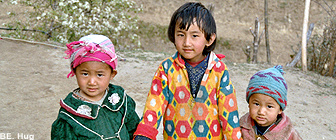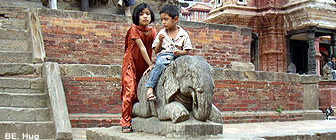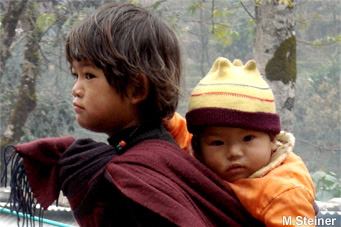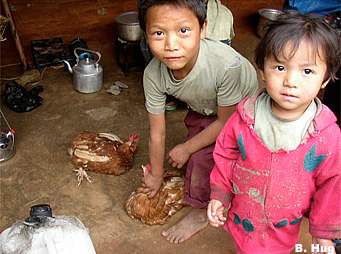 |
Nepal EDUCATION |
|
|
 |
 |
| Education
in Nepal |
 |
|
Community-run
schools make progress
|
| KATHMANDU,
9 Aug 2005 (IRIN)
|
|
A
government initiative to hand over the management of all state-run schools
to local communities has given new hope to parents and teachers alike in
Nepal, where the education sector has suffered due to years of conflict.
Since
the Maoist campaign to overthrow the government began nine years ago, education
has been one of the hardest hit development sectors. On the advice of aid
agencies, the government is continuing the process of decentralising the
public education system in line with the Local Self Governance Act of 1999.
In
the past two years, nearly 2,200 schools have been handed over to local
community control. The move followed calls by experts for the government
to relinquish power over a sector it could not control, especially in Maoist-controlled
villages. It was believed that poor, local communities would meet with
less interference as the Maoists tried to hang on to dwindling local support.
Under
the Community School Support Programme (CSSP) the government provides a
grant of nearly US $1,500 to each community-managed public school. Supported
and spearheaded by the World Bank, these schools will now be run independently
without any interference from the government. |
|
 |

|
"Such
an initiative can help Nepal to achieve its education goals," said education
expert Sanphe Lhalungpa from the United Nations Children's Fund (UNICEF).
The
programme has already proved to be a big success in enrolling children
in many districts, he said, noting one of the agency's key challenges was
preventing children from dropping out of education.
"What
makes the programme special is that we will be able to keep a lot of children
in school, which otherwise would not have been possible," Rajendra Joshi,
a senior education specialist of the World Bank, added.
Retention
of students, especially at the primary level, has always posed a big challenge
in the country of 28 million, which according to the United Nations has
one of the highest school dropout rates in the world. Analysts note that
the Himalayan kingdom had a record 70 percent dropout rate for children
between the ages of six and 10 years even before the armed Maoist rebellion
began. They believe with some certainty that those rates would undoubtedly
have worsened since.
 |
 |
 |
| Experts
cite a lack of school supplies, irresponsible and untrained teachers, combined
with a lack of child-friendly school environments, as the main causes.
"Most
of the government schools are so under-funded that they have to manage
with an annual budget of less than $150," Helen Sherpa from the World Education
Group (WEG) explained.
But
now experts believe that there could be progress. The government has plans
to hand over all 27,000 schools in a few years, providing a unique education
model to the developing world, according to international education specialists. |
|
The
community schools will be controlled by locally appointed committees consisting
of local social workers, teachers and parents who are primarily farmers,
labourers and ordinary villagers. They have the power to hire good teachers
and terminate those whose services fail to reach the required standard.
"In
the past, all the government has managed to do is appoint those teachers
who were politicised and not good enough," explained Joshi. "One thing
is for sure. When the community takes over, they would lose all the bad
teachers," he added.
Indeed,
according to the government's district education officers, many politically
appointed teachers neglect their duties altogether and remain absent for
months giving the Maoist problem as an excuse.
One
success being cited is community-managed schools in western Nepal, a region
badly affected by the Maoist insurgency. In the course of this year in
Banke district, nearly 700 km west of the capital Kathmandu, 21,632 children
were enrolled compared to just 17,318 in 2004, according to the World Education
Group.
"In
addition, 4,000 more children stayed in school, which proves that with
such effective community-based programmes, conflict is not necessarily
the real obstacle," said Sherpa.
While
many feel that this is an effective programme, they also note that the
government must continue monitoring school activities and provide more
guidance to local communities so that they can manage the schools effectively
in the long run.
Under
its Millennium Development Goals (MDGs), Nepal seeks the enrolment of all
its children in education by 2015 but analysts claim that the problem is
providing continuity to programmes. In the past, Nepal has had effective
programmes which were phased out even before the goals were achieved.
"The
government should realise that its responsibility does not end by handing
over its responsibilities to communities. Giving grants is not enough,"
education expert Labaraj Oli asserted.
Meanwhile,
there is some concern among educators whether communities are in fact capable
of managing the schools since they are not well educated themselves, neither
are they professionally trained.
"Such
prejudice only proves that we tend to look down on grassroots communities,"
said Joshi, who believes that communities are more responsible and accountable
when it comes to their children's schooling.
"This
is not about undertaking technical responsibilities but knowing who is
a good or a bad teacher," added Joshi
Shankar
Sharma, vice-chairman of the government's National Planning Commission,
maintained that at the core of the issue is the objective of securing peace
for Nepal.
"There
is a sign that we may be able to achieve our Millennium Development Goal.
It all depends on the intensity of the conflict. Once there is peace, we
could achieve about 75 percent of our goals," he said.
Credit
IRIN 2005
Copyright
© UN Office for the Coordination of Humanitarian Affairs 2007
[
This report does not necessarily reflect the views of the United Nations]
Integrated
Regional Information Networks (IRIN), part of the UN Office for the Coordination
of Humanitarian Affairs (OCHA). |
 |
 |
| Links |
 |
 |
 |
Externe
Links |

|
|
Children
from Kavre village, Dolakha district
|
|











